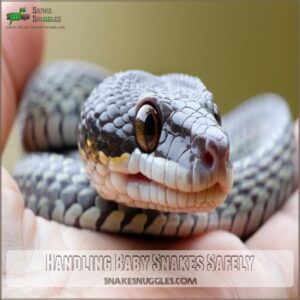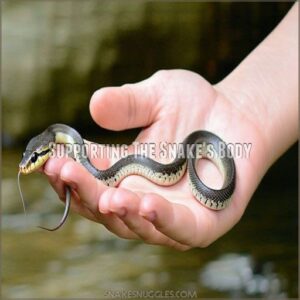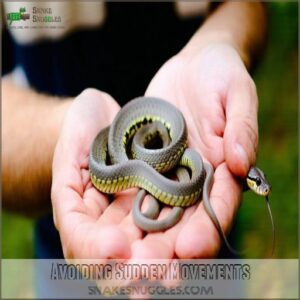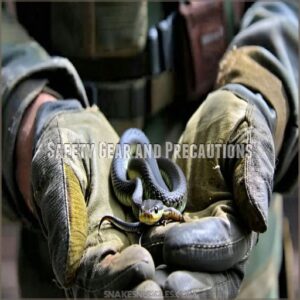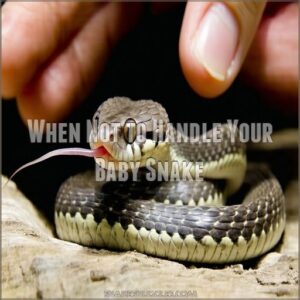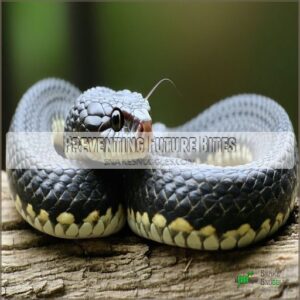This site is supported by our readers. We may earn a commission, at no cost to you, if you purchase through links.
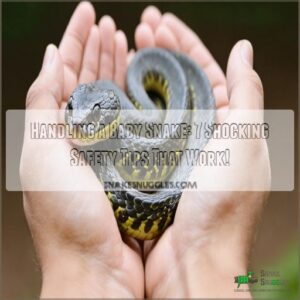
Start by creating a calm environment and washing your hands to remove potential triggering odors.
Support the snake’s entire body evenly, using both hands and moving slowly to avoid startling it. Always lift from the middle, providing full-body support, and keep handling sessions short and gentle.
Watch for stress signals like tail vibrations or defensive postures, and back off if the snake seems uncomfortable.
Remember, building trust takes time—be patient and consistent. Your goal is to make the snake feel secure, not threatened. Wondering how to spot those subtle stress cues that could make or break your snake interaction?
Table Of Contents
- Key Takeaways
- Handling Baby Snakes Safely
- Getting to Know Your Baby Snake
- Proper Handling Techniques
- Handling Corn Snakes Specifically
- Safety Gear and Precautions
- Common Handling Mistakes
- Taming Your Baby Snake
- When Not to Handle Your Baby Snake
- Managing Snake Bites
- Long-Term Handling and Care
- Frequently Asked Questions (FAQs)
- How do you handle a baby snake?
- How long should a baby snake handle?
- How to keep a baby snake from shedding?
- How do you handle a snake?
- How do you feed a baby snake?
- Could you handle ALL snakes even if you follow these rules?
- What do you do when a snake poops? Do you clean it right away?
- Can someone handle a viper?
- Can you handle baby snakes?
- Can you pick up a baby snake?
- Conclusion
Key Takeaways
- You’ll need to handle baby snakes with extreme gentleness, supporting their entire bodies evenly and moving slowly to prevent stress or defensive reactions.
- Recognize and respect your snake’s stress signals like tail vibrations, coiling, or sudden movements, which indicate when you should back off and give it space.
- Start with short, controlled handling sessions (5-10 minutes) twice weekly, gradually increasing the duration as your snake becomes more comfortable with human interaction.
- Always prioritize the snake’s well-being by creating a calm environment, maintaining proper temperature and humidity, and avoiding handling during sensitive periods like shedding or feeding.
Handling Baby Snakes Safely
When you’re ready to handle a baby snake, understanding its unique behaviors and needs is essential for your safety and the snake’s well-being.
By mastering gentle handling techniques and recognizing stress signals, you’ll build trust with your scaly companion and create a positive interaction that benefits both of you.
Pre-Handling Precautions
Before handling a baby snake, someone must prepare a clean, safe space that minimizes potential risks.
Assess the snake’s temperament by observing its behavior carefully.
Create a calm, controlled environment free from sudden movements or loud noises. baby snake handling
Make certain your hands are clean and warm, avoiding anything that might startle or stress the delicate creature during handling. a baby snake
Choosing The Right Time
Timing is everything when handling baby snakes—it’s like maneuvering a delicate dance of patience and respect. Your success hinges on understanding when to approach these fragile creatures. To minimize risks, invest in a suitable baby snake holder.
- Wait until the snake is calm and alert
- Avoid handling immediately after feeding
- Choose times when the snake seems relaxed
- Skip handling during shedding periods
- Observe the snake’s mood and energy levels
The right moment can transform your interaction from stressful to spectacular.
Ensuring a Safe Environment
A fortress of safety begins with your snake’s sanctuary.
Secure the enclosure with tight-fitting, mesh-ventilated lids that prevent any Houdini-like escapes.
Maintain precise temperature gradients and humidity levels, creating a controlled environment that mimics natural habitats.
Choose substrate carefully, eliminating potential hazards and ensuring your baby snake feels protected and comfortable in its new home.
Getting to Know Your Baby Snake
Your baby snake isn’t just a pet; it’s a complex creature with unique behavioral patterns.
Understanding your snake’s body language and stress signals is essential.
This is crucial for building trust and ensuring safe, successful handling experiences.
Understanding Body Language
Your baby snake’s body language is a secret communication system you’ll want to master.
Head posture, tail position, and tongue flicking reveal volumes about their emotional state during handling.
Watch for subtle shifts in body stiffness that signal comfort or unease.
Learning these snake handling techniques will help you understand your slithery friend’s unspoken signals and build trust seamlessly.
Recognizing stress signals like tail vibrations can also be essential in preventing defensive postures during handling.
Recognizing Stress Signals
Snake stress cues are like nature’s warning lights.
Watchful handlers spot defensive body postures: coiled tight, head raised, or S-shaped strike position.
Unusual sounds like hissing scream "back off!" Escape attempts signal pure panic.
When a baby snake pulls away, freezes, or flattens its body, it’s broadcasting major discomfort. Reading these signals prevents potential bites and builds trust.
Building Trust
Trust-building with a baby snake is like learning a delicate dance of mutual respect.
Your journey begins with understanding their unique personality and comfort level.
5 key strategies for building trust:
- Move slowly and predictably
- Provide consistent, gentle interactions
- Respect the snake’s personal space
- Use calm, quiet handling techniques
- Offer positive reinforcement through patient approach
Patience transforms your relationship from uncertain to harmonious.
Proper Handling Techniques
When handling a baby snake, you’ll need to master techniques that guarantee both your safety and the snake’s comfort.
By supporting its body, moving slowly, and understanding its unique signals, you’ll build trust and minimize the risk of stress or accidental injury.
Supporting The Snake’s Body
After decoding snake body language, mastering gentle support becomes your next challenge.
Cradle the baby snake’s body with both hands, creating a secure bridge from wrist to wrist.
Distribute weight evenly, preventing unnecessary pressure. Imagine holding delicate glassware – firm yet soft.
Keep movements smooth, supporting the entire length without squeezing.
Your goal: make the snake feel completely supported and unthreatened.
Avoiding Sudden Movements
When supporting your snake’s body, smooth handling demands a slow, deliberate approach. Sudden movements trigger a primal defense mechanism, transforming your gentle companion into a bundle of nerves.
To master the art of safe snake handling, remember these key strategies:
- Move like a sloth on vacation
- Keep your hands steady and predictable
- Breathe calmly and quietly
- Lower your body to the snake’s level
- Practice zen-like patience during interactions
Your calm demeanor speaks volumes.
Preventing Bites
Stay one step ahead of potential snake bites by mastering scent control and gentle handling techniques.
Minimize bite risks by washing your hands to remove rodent odors that might trigger a defensive response.
Move slowly, approach from the side, and let your baby snake feel secure in safe spaces.
Your calm demeanor is your best snake bite prevention tool.
Handling Corn Snakes Specifically
When you’re handling a corn snake, you’ll want to master the art of gentle, confident lifting that supports their entire body.
Remember that these small serpents are more scared of you than you’re of them, so approach with a calm demeanor.
Let them explore your cupped hands at their own comfortable pace.
Gentle Lifting Techniques
Mastering gentle lifting techniques transforms your baby snake handling from nerve-wracking to confident.
Your approach determines everything when supporting a delicate reptile’s body.
- Position your hands beneath the snake’s mid-section
- Move with deliberate, slow movements
- Keep your grip soft yet secure
Minimizing stress requires a calm demeanor and understanding that each snake has its unique comfort level during handling techniques.
Allowing Exploration
After gently lifting your baby corn snake, let’s discover the art of supervised exploration.
Create a controlled environment where your snake can safely unravel its curiosity.
Your patience becomes the bridge between nervousness and trust.
| Safe Space | Exploration Strategy |
|---|---|
| Soft Surface | Cupped Hands Method |
| Limited Area | Gentle Guidance |
Remember, baby snake behavior thrives on positive reinforcement and gradual freedom.
Handling Frequency
Once your baby corn snake gets comfortable exploring your hands, it’s time to nail down a smart handling schedule.
Your baby corn snake is exceptionally easy to handle due to its low activity and non-venomous nature, which makes it a great beginner’s choice for safe handling practices.
Your handling frequency matters big time for building trust and reducing stress.
Here’s your game plan:
- Start with 2-3 short sessions weekly
- Limit each session to 10 minutes max
- Watch your snake’s body language closely
- Adjust based on individual snake behavior
- Increase handling gradually as confidence grows
Safety Gear and Precautions
When handling a baby snake, your safety depends on proper protective gear.
proper protective gear and calculated precautions.
You’ll need sturdy gloves, closed-toe boots, and a calm demeanor to minimize risks.
and guarantee a secure interaction with your small, potentially unpredictable reptilian companion.
Using Gloves and Boots
When handling a baby snake, safety gear can be your first line of defense against potential bites and handling hazards.
Protective wear is essential for responsible snake handling, especially with unfamiliar or potentially venomous species.
| Gear Type | Purpose | Protection Level |
|---|---|---|
| Thick Gloves | Direct Contact | High |
| Sturdy Boots | Foot Protection | Medium |
| Long Sleeves | Arm Coverage | Medium-High |
| Snake Hook | Distancing Tool | High |
Applying Minimal Pressure
If you’re handling a baby snake, mastering a gentle grip is essential for both your safety and the snake’s comfort. Minimal pressure prevents stress and potential defensive responses.
- Your touch should whisper, not shout
- Every finger counts in creating trust
- Soft hands = calm snake
- Avoid crushing delicate reptile bodies
- Precision beats force every time
Carefully support the snake’s body without squeezing, using controlled movements that respect its fragile structure and natural instincts.
Avoiding Hazardous Situations
Minimizing pressure doesn’t stop at touch—you’ll need hawk-like vigilance for snake handling safety.
Keep your workspace clear of sharp objects, electrical cords, and potential escape routes.
Children and pets must stay supervised. Remove jewelry that could snag or frighten your snake.
Always handle in a calm, enclosed area with soft surfaces, preventing accidental drops or startling movements.
Common Handling Mistakes
You might think handling a baby snake is straightforward, but it’s fraught with potential mistakes.
These mistakes can stress or harm your delicate reptilian friend.
Understanding these common errors can mean the difference between a successful, safe interaction and a potentially dangerous encounter.
This encounter could traumatize both you and your snake.
Grasping The Head or Tail
Never try to grab a baby snake by its delicate head or fragile tail – this spells disaster for snake handling safety.
Supporting the body prevents stress and potential injury.
Applying pressure near the neck can trigger defensive bites, while mishandling the tail risks permanent damage.
Always lift snakes from the middle, providing full-body support with gentle, confident hands to guarantee both your safety and the snake’s well-being.
Handling During Shedding
During shedding, your baby snake becomes a delicate creature with heightened sensitivity.
Touching them can cause significant stress and potential damage to their emerging new skin.
Resist the urge to handle your snake during this vulnerable period, which typically lasts 3-7 days.
Wait patiently until the skin removal process completes naturally, ensuring your snake’s comfort and health.
Ignoring Stress Signals
Shedding can leave your snake feeling vulnerable, but ignoring their stress signals is a recipe for disaster.
Watch for telltale bite risk indicators like hissing, coiling, or rapid tongue flicking. These baby snake care warnings scream "back off!"
Misreading snake behavior can transform a calm reptile into a defensive attacker. Pay attention, and you’ll avoid the most common owner mistakes in handling newborn snakes.
Providing a comfortable environment with proper temperature and humidity levels, as well as enrichment items, is paramount in minimizing stress during handling.
Taming Your Baby Snake
Taming a baby snake requires patience, consistent handling, and understanding its unique behavioral patterns.
You’ll need to approach your scaly companion with calm, gentle movements.
Gradually building trust through short, regular interactions that respect the snake’s comfort level and natural instincts. Taming a baby snake requires a delicate approach.
Acclimating to Human Presence
Introducing your baby snake to human presence requires three strategic steps for successful acclimation.
- Position your hand slowly near the enclosure, allowing the snake to become familiar with your scent.
- Maintain a consistent, gentle presence without sudden movements.
- Spend brief moments near the habitat, creating a calm, predictable environment.
Patience transforms your interactions, turning potential anxiety into trust through responsible, gentle snake handling techniques.
Gradual Handling Increase
After establishing initial contact, slowly increase your handling sessions with your baby snake, keeping in mind that most snakes require a taming time of one to six months to fully acclimate.
Start with short 5-minute interactions, gradually extending to 10-15 minutes as your snake’s stress indicators remain low.
Watch for signs of comfort – calm body posture, relaxed movement.
Patience is key in responsible snake handling, allowing your newborn snake to build trust at its own pace.
Positive Reinforcement
As you gradually increase handling times, positive reinforcement becomes your secret weapon.
Soft praise, calm movements, and patience work wonders with baby snakes.
Rewards like gentle strokes and quiet talking help your snake associate handling with safety.
Consistency is key – short, stress-free interactions build trust and reduce anxiety during snake handling techniques.
When Not to Handle Your Baby Snake
You can’t handle a baby snake when it’s clearly showing signs of stress, shedding, or experiencing health issues.
Pay close attention to your snake’s body language and physical condition to guarantee safe, comfortable interactions that prevent potential harm to both you and your reptilian friend.
Signs of Stress or Aggression
Right from the get-go, recognizing signs of stress or aggression can save you and your baby snake from potential mishaps.
Watch for defensive postures like muscle tension, tail thrashing, or sudden hiding behavior.
Hissing sounds scream "back off!"
If your snake seems wound up tighter than a spring, it’s not the moment to handle newborn snakes.
Patience wins every time.
Feeding or Shedding Time
When stress signals emerge, hands off your baby snake during feeding or shedding times. These delicate periods demand zero handling to prevent unnecessary anxiety or potential injury.
- Feeding disrupts digestion and triggers defensive behaviors
- Shedding requires undisturbed energy for skin renewal
- Touching can damage fragile new skin during post-shed care
Respect your snake’s biological rhythm and watch it thrive in peace.
Health Issues
If your baby snake seems under the weather after shedding, pause all handling immediately.
Watch for warning signs like lethargy, abnormal breathing, or unusual discharge.
Preventative care means scheduling regular veterinary visits and monitoring your snake’s behavior. Parasite control and early disease detection can prevent serious health complications. Your snake’s well-being trumps your handling desires.
Managing Snake Bites
If you’re handling a baby snake and get bitten, don’t panic—most snake bites from young snakes are harmless and rarely require serious medical intervention.
Understanding the immediate steps for managing snake bites can help you stay calm and respond effectively, ensuring both your safety and your snake’s well-being.
Recognizing Bite Symptoms
Despite the best handling techniques, baby snake bites can catch you off guard like a surprise party guest.
Bite severity varies, but knowing the symptoms is your first line of defense in snake handling.
Look out for:
- Localized redness and minor swelling
- Slight pinching or stinging sensation
- Minimal bleeding or tiny puncture marks
Assess pain levels carefully and stay calm.
First Aid Procedures
Spotting a snake bite means quick action for baby snake wound care.
Clean the area immediately with mild antiseptic soap and cool water. Apply gentle pressure to control bleeding, and cover with a sterile bandage.
Contact your healthcare provider or local poison control for professional guidance.
Monitor the bite site for signs of infection or allergic reactions.
Preventing Future Bites
After patching up any snake bites, smart handlers focus on prevention through strategic snake handling techniques.
Minimize bite triggers by controlling your scent, understanding snake body language, and reducing stress during interactions.
Wear protective gloves, move slowly, and learn your snake’s unique communication signals.
Early socialization and consistent, gentle handling create a foundation of trust between you and your serpentine friend. Prevention is key to safe handling.
Long-Term Handling and Care
As a baby snake owner, you’ll need to maintain consistent handling routines.
while prioritizing your snake’s physical and mental well-being through strategic enrichment and health monitoring.
Your long-term care strategy should focus on creating a stable, stress-free environment.
that supports your snake’s growth, behavioral development, and overall health through careful, methodical interactions. Long-term care and consistent handling are key.
Regular Handling Sessions
If a snake bite mishap hasn’t shaken your confidence, regular handling sessions are your ticket to a trusting relationship.
Aim for consistent, short interactions twice weekly.
Young snakes need gentle, gradual exposure—start with 5-10 minute sessions to avoid overhandling.
As your snake grows more comfortable, slowly increase duration.
Watch for stress signals, and always prioritize the snake’s body language during handling techniques.
Providing Environmental Enrichment
Keep your baby snake’s world exciting with smart environmental enrichment!
Choose varied substrate choices like aspen shavings mixed with safe bark.
You can also consider purchasing specialized baby snake hides to create a sense of security for your snake.
Add multiple hide types – a warm retreat, cool spot, and humidity box.
Include secure climbing structures such as branches and vines.
Rotate sensory items periodically to prevent boredom and stimulate natural behaviors, making snake husbandry a dynamic experience.
Monitoring Health and Hygiene
Your snake’s health is the compass guiding its survival, and monitoring requires a sharp eye. Think of your snake’s well-being like a detective’s investigation.
Watch for these red flags:
- Unexpected weight changes
- Irregular shedding patterns
- Unusual skin discoloration
- Respiratory distress signals
Regular vet visits and thorough enclosure cleaning can prevent most health nightmares, transforming potential snake emergencies into manageable moments.
Frequently Asked Questions (FAQs)
How do you handle a baby snake?
Gently cradle a baby snake like a delicate treasure, supporting its entire body with soft, calm hands.
Move slowly, respect its space, and limit handling to short sessions.
Letting the tiny serpent explore with confidence and trust.
How long should a baby snake handle?
Limit handling baby snakes to 5-10 minutes, twice weekly.
Gradually increase duration as they become comfortable.
Always support their body, move slowly, and watch for signs of stress or discomfort during interactions.
How to keep a baby snake from shedding?
Irony strikes: think shedding’s a snake’s beauty routine?
Maintain ideal humidity between 40-50%.
Provide rough surfaces like bark or rocks.
Mist the enclosure lightly to help your baby snake slip smoothly into its new skin.
How do you handle a snake?
Support the snake’s body with both hands, approaching slowly from the side.
Avoid sudden movements.
Handle for short sessions, and wash your hands before and after.
Never grasp the head or tail, and stay calm.
How do you feed a baby snake?
Like a careful chef plating a delicate appetizer, you’ll want to thaw frozen pinky mice completely.
Feed your baby snake prey no wider than its body.
Typically every 5-7 days, and always supervise mealtime closely.
Could you handle ALL snakes even if you follow these rules?
No, you can’t safely handle all snakes. Some are venomous, aggressive, or unpredictable. Always research the specific species, understand its temperament, and consult experts before attempting to handle any snake.
What do you do when a snake poops? Do you clean it right away?
Clean snake poop immediately to prevent bacteria growth and odor.
Wear gloves, use disposable wipes or paper towels, and disinfect the area thoroughly with a reptile-safe cleaning solution.
to maintain a hygienic enclosure.
Can someone handle a viper?
You shouldn’t handle a viper without professional training.
These venomous snakes require specialized expertise, protective equipment, and extreme caution.
Only trained herpetologists or experienced wildlife handlers can safely interact with vipers. Professional training is essential.
Can you handle baby snakes?
Imagine tiny, delicate serpents waiting to be held!
Gently support baby snakes with patience and care.
Keep handling sessions short, move slowly, and learn their unique temperament to build trust and minimize stress.
Can you pick up a baby snake?
When approaching baby snakes, gently support their entire body from the side, minimizing stress.
Move slowly, let them explore your hands, and keep handling sessions brief.
Always wash hands before and after contact for safety.
Conclusion
Ultimately, handling a baby snake requires patience, respect, and knowledge.
You’ve learned critical techniques to guarantee both your safety and the snake’s comfort.
Remember, trust isn’t built overnight—it’s a gradual process of gentle interactions and understanding. By mastering these handling techniques, you’ll transform potential fear into confident, responsible snake care.
Stay observant, move slowly, and always prioritize the snake’s well-being when handling a baby snake. Your commitment will make all the difference.

